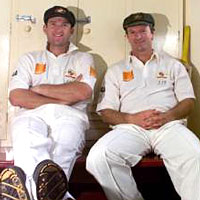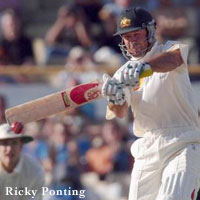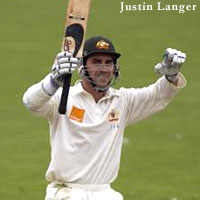Heavyweights trade early jabs
Daniel Laidlaw
Australia landed the first blows through Justin Langer before South Africaís
Claude Henderson struck a few of his own to leave the first Test of the
world championship series between Australia and South Africa evenly poised
after the first day.
With his third hundred of the season, Langer threatened to take the opening
day away from South Africa in a second-wicket partnership of 102 with Ricky
Ponting before the latterís costly run out for 54 at 182/1 changed the
course play. From a position of confidence, Australia slumped again to lose
6/64, as South Africa reversed an ordinary start with some restrictive
bowling in the last session.
 Steve Waugh, playing his 100th Test alongside twin brother Mark, won a
useful toss and elected to bat, ensuring Australia would not have to bat
last when the bounce is predicted to be inconsistent.
Steve Waugh, playing his 100th Test alongside twin brother Mark, won a
useful toss and elected to bat, ensuring Australia would not have to bat
last when the bounce is predicted to be inconsistent.
The Australians selected an unchanged line-up as expected, with Waugh
revealing that the selectors had insisted on playing four frontline bowlers,
ending any thoughts of including MacGill as a fifth bowler and dropping a
specialist batsman. Allan Donald was South Africaís significant omission,
not deemed match fit, which enabled Ntini to be selected to avert any
political problems. The Proteas also persisted with their established team,
meaning they decided not to include rookie batsman Jacques Rudolph as had
been anticipated, leaving Kallis at No. 3 with Dippenaar in the middle
order.
Pollock and Hayward opened the bowling, with the latter pushing into the
high 140k range in just his first over. At the toss, Waugh had said he
expected there to be a little in the pitch in the morning, and that it was
all about getting through the first session. For its part, the pitch was an
unusual motley colour, and featured some alarmingly low bounce early in the
session and occasional variation through the day. At times early in his
first spell, Pollock struggled to get the ball through to Boucher.
What seam movement was available was not exploited by Pollock and Hayward,
with Pollock bowling a full length outside off that mostly allowed the
openers to leave, or saw Langer slam him through the covers when he
overpitched. Hayward was less accurate than his skipper and an eager Langer,
in particular, was quick to seize on anything he found to be loose with
confident driving.
In fact, the openers were relatively untroubled in the first half hour,
beaten only twice and usually either scoring runs or allowing the ball to
pass, rarely made to lay bat on ball defensively. Langer, the dominant
batsman, was troubled more by the straighter deliveries tucking him up on
his pads than those full and wide of off, from which he scored prolifically
against Hayward.
With Pollock and Hayward having produced few deliveries of genuine menace,
Makhaya Ntini was introduced after an hour and his first three deliveries
were all half-volleys despatched to the short cover boundary by Langer,
prompting Pollock to have a chat with his wayward quick. Ntiniís next over
was a maiden, but after being pulled for consecutive fours by Hayden in his
third, was consigned to fielding duties in favour of Klusener.
Kallis had also come on in a double change with the openers flourishing in
what was beginning to become a surprisingly easy batting picnic. Through
more than an hour, the famously disciplined Proteas had done nothing to stem
Australiaís typical scoring rate, as Langer and Hayden were going at 4.5 per
over. Just when it seemed that South Africaís attack might be exposed as
over-rated, though, they displayed their imposing depth with the job
performed by Kallis and Klusener.
Kallis easily swung the ball more than any of his team-mates, striking
Hayden on the pad with one that came back, Haydenís massive stride forward
the only thing that saved him. Soon after, however, it was Klusener who made
the breakthrough, having Hayden caught at mid off for 31 to make Australia
80/1.
It was an embarrassingly soft dismissal for a top order batsman, as Hayden
appeared to simply get through his drive too early in lobbing a simple catch
off the outer edge of the bat to Ntini at mid off. Kallis and Klusener had
been more disciplined, though, and the wicket was South Africaís reward.
They should have made it two when Gary Kirsten put down a straightforward
catch off Ponting just three minutes before the break. Pollock persisted
with Kallis when he might have considered bringing himself back, which
should have proved the right move as Ponting, lunging hard at the ball off
the front foot as he does too often too early than is prudent for a
consistent top order batsman, got a thick outside edge to third slip where
the ball went right through Kirstenís hands.
The score was 88/1 and that was the way it stayed at lunch, with Langer 44
and a reprieved Ponting on 7.
 Ponting remained unconvincing but his edginess was mitigated by an apparent
back injury he carried into the match. It seemed to hinder his movement and
running between wickets, and he did back stretches between overs before
being treated by the physio.
Ponting remained unconvincing but his edginess was mitigated by an apparent
back injury he carried into the match. It seemed to hinder his movement and
running between wickets, and he did back stretches between overs before
being treated by the physio.
Following his regimented bowling strategy, Pollock returned in tandem with
Hayden after lunch, with the skipper having adjusted to bowling a little
shorter and straighter, making Langer play forward defensively more often.
Australia reached 100 at a rate of 3.17 per over and Langer reached his
fifty by cutting Hayward to the rope, before almost being run out in a
moment of madness.
Langer pushed to off and decided to take on the deadly arm of Gibbs swooping
from cover. Despite the desperation dive, he would have been out had the
throw not gone over the top of the stumps. No Australian batsman would
surely want to test Gibbs a second time, despite the favour he once gave
them with a certain dropped catch in the World Cup.
Hayward, consistently bowling in the 140s, was replaced by Klusener, who
immediately beat Langer with an off-cutter. It was Pollock, however, who
should have had a wicket when he had Ponting caught off a no-ball. With the
score at 126/1, Ponting was rushed into an uncontrolled hook against an
accurate bouncer, the top edge flying to the man placed at deep square leg.
The no-ball call by rookie umpire Simon Taufel was marginal in the extreme,
yet it was Pollockís 6th no-ball and had to happen eventually. South Africa
had spurned their third opportunity, albeit unluckily, but those are the
kind of chances which have to be taken to topple the No. 1 team at home.
Left-arm spinner Claude Henderson was introduced midway through the session
and both batsmen showed an eagerness to use their feet against him. Though
batting under duress, Ponting was still fluent, and after South Africa had
gifted him a start he and Langer loosened the touristsí grip with fluid
strokeplay. A tiring Klusener was relieved by Kallis and Langer cut
boundaries from both, as he and Ponting raised their hundred partnership.
Australia were progressing comfortably and with increasing confidence when
tragedy struck in the form of a terrible call by Langer. In the 90s, Langer
played Henderson defensively to cover and madly took off, giving Ponting no
chance. Ponting responded immediately but Dippenaarís pick up and throw to
Boucher was clean and accurate, with only confirmation from the TV umpire
needed. Entirely Langerís fault, Ponting was gone for 54, leaving Australia
182/2.
 Nantie Hayward was brought back to bowl at Mark Waugh with his sharp lifters
but first Langer reached his century, leaping down the pitch to blast
Henderson over the mid wicket boundary for six. It was a brilliant way to
raise the milestone, his fourth hundred in five Tests since his
reincarnation as an opener.
Nantie Hayward was brought back to bowl at Mark Waugh with his sharp lifters
but first Langer reached his century, leaping down the pitch to blast
Henderson over the mid wicket boundary for six. It was a brilliant way to
raise the milestone, his fourth hundred in five Tests since his
reincarnation as an opener.
The celebrations were short-lived, as South Africa capitalised on Pontingís
run out by removing Mark Waugh for 2 three minutes before tea. With his
weight on the back foot, Waugh leaned back and aimed to play an ambitious
cut against Hayward, but could only nick behind to Boucher. It was a loose
shot, leaving Australia 199/3, and Steve Waugh only had time to show Mark
how it was done with an authoritative back foot drive before tea was taken
at 203/3, with Langer 104 and S. Waugh 4.
Pollock and Hayward opened the last session with their best combined spells,
maintaining a tight line that allied with Australiaís determination to keep
wickets intact, saw a dramatically slowed scoring rate. Hayward tried going
around the wicket to dislodge Langer and predictably tested Waugh by bowling
short at him with a leg gully, but neither had an immediate affect as both
sides settled in to a grim battle.
Waugh was denied freedom to play shots and with Australia focussed on
defence, Pollock shifted tactics by bringing Henderson on for Hayward. The
change had an instant impact, as Waugh was dubiously caught at silly point
to put Australia on the back foot at 211/4.
Henderson sent down a looping delivery that drifted to leg, Waugh missed an
attempted flick to the on side and the ball ballooned up from his shirt to
McKenzie in close. Waugh thought nothing of the appeal and was clearly
displeased to see umpire Venkatís finger go up, as there had been no edge.
The loss of Waugh saw Australia, with the run rate spiralling down, dig in
even further against a testing Henderson and an improved Ntini as the
momentum shifted back to South Africa. Just 17 runs were scored in the hour
as the Proteas, with a containing field, successfully closed down the runs
with the kind of restrictive effort that had been expected earlier. Not only
did it cut off the runs, it brought wickets, too.
With Langer and Martyn reduced to scrambling occasional singles, it seemed
South Africa, through Ntini and Henderson, wanted to maintain a holding
pattern until the second new ball became due and they attack again. But
unexpectedly, it was the spin of Henderson that proved the most productive
form of attack.
With just four balls until the second new ball, the hitherto patient Langer
succumbed to frustration. Shaping to cut a Henderson delivery short of
length outside off, the ball bit off the pitch to spin back sharply over the
off stump, and Langer edged a cramped cut to Pollock at slip as he backed
away. With Langer gone for 116, Australia were a vulnerable 238/5, and in
the middle of another slump after being 182/1 before Pontingís pivotal run
out.
Fan favourite Gilchrist got an eager reception and began expansively with a
cover driven four before becoming Hendersonís third victim for just 7.
Looking to pull, the delivery was not short enough for the stroke and he
could only lift it to Hayward set back at mid wicket. The Australian middle
order, again showing a damning lack of resolution, had collapsed to reduce
the hosts to 246/6. After a relative lack of discipline earlier, South
Africa had tightened up considerably and made the most of their chances.
Captain Pollock, who had delayed taking the new ball after Hendersonís
strikes, had his hand forced when Ntini strayed again and Martyn took 14
from an over. In six overs from Pollock and Hayward, Martyn and Warne held
firm to see the hosts to stumps at 272/6.
After a jostle for position which saw first Australia and then South Africa
with the ascendancy, the first match of the world championship, as might
have been expected, is wide open.
Match report: Day 2
Scorecard:
Australian 1st innings |
South African 1st innings
Images:
Day 1 | Day 2
More Columns
Mail Daniel Laidlaw